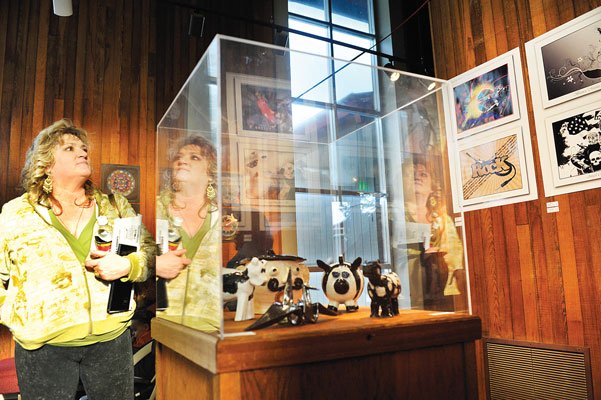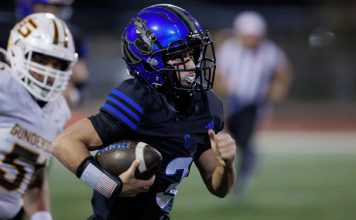With Gilroy Unified School District teachers facing millions in
budget cuts and meager school funding, teachers of art, music and
physical education are no strangers to living on the edge. In the
wake of fiscal crisis and other districts losing arts programs all
together, GUSD is doing its best to hold ground.
Veteran choral instructor Phil Robb spoke in food analogies as he underscored the fundamental importance of the arts in education.
If TV and movies are the only pop culture students are exposed to, “that’s very limited,” he explained. “It’s like having sugar pops for breakfast. They also need eggs, bacon and French toast.”
With Gilroy Unified School District teachers facing millions in budget cuts and meager school funding, teachers of art, music and physical education are no strangers to living on the edge.
In the wake of fiscal crisis and other districts losing arts programs all together, GUSD is doing its best to hold ground.
“I don’t consider those programs something that can be dropped from our goal of educating the ‘total student,’ ” said GUSD Board president Rhoda Bress. “We have done a very good job of maintaining visual and performing arts despite the situation.”
Recent budget balancing for GUSD came close to hurting music and P.E. at the elementary levels, though, and the situation isn’t looking any better in the coming years, fiscally speaking.
Which poses the question: Where is future of arts education for Gilroy schools headed?
“They always put it on the table and they always take it off the table, but this year was the closest we ever came,” said GUSD Music Specialist Anita Siegel, who teaches music at four different GUSD elementary schools.
Prior to it being withdrawn by GUSD administration a few weeks ago, the recommendation to eliminate fourth and fifth grade music and P.E. classes was on the table.
“They are too critical to cut,” said Bress. “That was going to be my position if it came to a vote.”
Several other trustees took a similar stance. Trustee Mark Good said it would make just as much sense to cut mathematics as it would to cut music or physical education.
“We have to educate the entire child, and it requires all those things,” he said.
Numerous studies, he pointed out, prove students who participate in the arts achieve at a higher level in the harder subjects such as reading, writing and arithmetic.
But with GUSD being roughly $356,000 shy in its budget plan for the “worst case scenario” – which will come to fruition should temporary tax extensions fail to pass in a possible special June election – fiscal curveballs always seem to be in the mix.
This of course doesn’t do anything to bolster morale of P.E., art and music instructors. They’re well aware state and federal expectations funnel heavy emphasis and funding toward reading, writing and arithmetic.
“It’s easy to get defeated after you argue for a long time that what you do is valuable,” said Robb motioning inside Christopher High School’s choir room. “For them, this becomes a piece of icing. It’s not really the cake.”
As it is, GUSD Superintendent Debbie Flores confirmed the district will be removing art instruction from South Valley and Brownell Middle schools next year. Currently one teacher teaches three periods a day, five days a week at each school in the morning and afternoon.
Ascencion Solorsano Middle School does not have a fine arts program.
Siegel, who has been with GUSD for eight years, said she wants to see equal access to performing and visual arts during the school day for all children. But as a part-time music instructor spread between four elementary schools, time is tight.
“When these children learn how to interpret something other than ABC or 123, their brain is learning to interpret another language,” she said. “It really sets into motion a brain connection you wouldn’t otherwise get.”
Robb echoed this point.
“I know in choral music we’re exercising every aspect of the brain. We’re using both lobes – even this part back here,” he said tapping on the back of his skull with his fist.
GUSD Superintendent Debbie Flores strongly agreed, but pointed out administrators are in a Catch-22.
“We’re all proponents of it, we have children in it, we believe in it,” she said. “At the same time we have to balance our personal beliefs in music and arts and balance the budget – and it’s been hard.”
Flores and Bress reminded instructional classroom time allotted to subject matters for which the district is held accountable also leaves little time for electives.
Gilroy High School Art teacher Annie Tobin said the emphasis and priority placed on test scores now suffocates other subjects that are ancillary.
“Art doesn’t score. So if there’s no test for you, then out you go,” she said. “The reality is what they learn in these classes helps them in the rest of their scores, so education is shooting itself in the foot.”
Tobin – who has been with GUSD for 12 years – pointed out as junior high art resources decrease, she’s noticed a direct decline in students going into high school who are interested in taking classes such as drawing and painting.
Robb, who has been with GUSD for 27 years, brought up a similar concern for music classes which have also dwindled over the decades.
“What I’m finding is because we already have eliminated so much from elementary schools, more and more kids are afraid to enter into it when they get to high school because they’re so self-conscious.”
Tobin reminded art is essential as it disciplines students to look at scenarios through multiple perspectives, to function outside the box, creatively solve problems in a nonlinear approach and think on their feet.
If students don’t learn to improvise, be adaptable and flexible “in the way art provides you the ability to do that,” she said, what are they going to do when they get out into the real world?
Robb said students who don’t participate in extracurricular artistic activities or partake in private music lessons end up absorbing most of their cultural perspective from media-driven outlets.
“Music gives them a whole other venue. We’re exposing them to who we are as people, exposing them to our past, what has made us a society,” he said.
Compared to other districts, however, Flores pointed out GUSD has fared much better in terms of program preservation.
“At the elementary level, most districts have no arts and music programs anymore,” she said. “Those went away a number of years ago. But in our district, that’s been an area of focus for a long time.”
She said GUSD still fosters a number of rich liberal arts traditions. A small handful of examples include extensive band and choir programs at the high school levels, a strong symphonic and concert band program at the junior high schools, the Theatre Arts program at Rucker Elementary, the violin program at Antonio Del Buono Elementary, Ballet Folklorico Los Diamantes at Rod Kelley Elementary and a districtwide annual Run For Fitness in the spring. A private grant from the O’Connell family administered through the Gilroy Foundation continuously supports music at the elementary level as well.
Bress said a close spotlight on the arts is an upcoming agenda item for trustees, as is developing a stronger relationship with Gilroy’s Arts and Culture Commission and partnering with the community to offer a more comprehensive program than what is currently available.
“It’s a real dilemma for all of us,” said Flores, highlighting the board’s support for music and arts programs while adhering to a fiduciary responsibility to ensure a balanced budget. “We just don’t have the funds.”
Robb said education leaders are constantly dealing “with what just happened,” which deters them from being able to look ahead at the bigger picture.
“Why is it Japan requires music in elementary schools?” he asked. “We’re plugging up holes, and that’s unfortunate. We’re not laying groundwork for something broader.”













